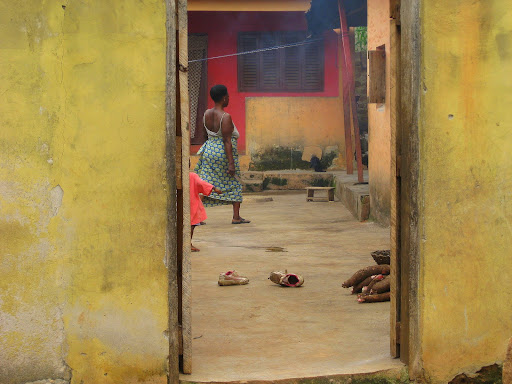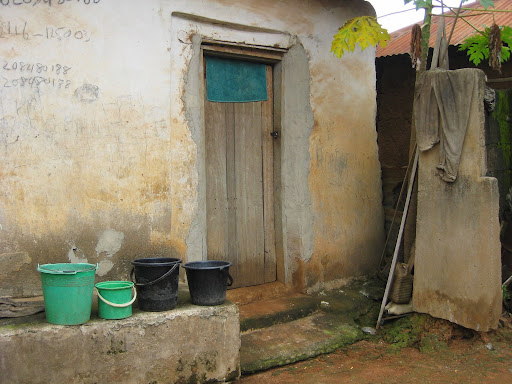For those of you keeping up, sorry it’s been a long time since I’ve added any entries. I think there have been three weekends since I last updated. The weeked after my last entry I went to the beach at Kokrobite, just 45 minutes west of
Accra. After so much travel, it was nice to go somewhere close just for the day. Beaches here are not exactly the Riviera; there is a considerable amount of trash everywhere and a 20 minute walk in the wrong direction led us to where the sewer from the town empties into the ocean (about as unpleasant as you would expect). We had a good time, but it was just a day trip and there aren’t really any exciting stories from that weekend that I can remember (other than the sewer that is).
The next weekend we went to Kumasi, which is the second largest city in Ghana and the capital of the Ashanti region. It is also home to the largest open air market in west Africa. We took the STC bus there, which is large, air conditioned, and shows movies! Ghanaian movies are hard to describe; they really are something that must be experienced. If you’re lucky, sometimes they’ll show a Nigerian movie, which is like a Hollywood production compared to the Ghanaian movies. Ghanaian movies are typically pretty hokey and always terribly sexist, and are serials consisting of several parts (anywhere from 4 parts on up). If the STC bus is good for nothing else, it at least forces you to have some exposure to local popular culture. We departed after work on Friday and arrived in Kumasi just after midnight. Luckily our hostel was next to the bus station and the 9 of us rented out an entire 8-bed room. On Saturday we headed out to Adomwomase , a small Kente cloth weaving village. The village has a community tourism project, and in order to attract tourists, hawkers are forbidden and people are discouraged from heckling travelers. It really made all the difference, and is probably the only place I have been in Ghana where I didn’t have to fight my way through crowds intent on selling me something. If anyone plans on traveling to Ghana, I highly recommend it, you’ll need a break from all the hassle and hustle of daily life everywhere else. We took a tour of the village and got to see the Chief’s palace, some Kente weavers, cocoa, cassava, and plantain farms, and got the history of the village. Apparently, thousands of years ago, a person was buried alive as a sacrifice to the gods and a tree was planted over top of that site. That tree formed the center of town and supposedly still stands today.
After buying some Kente cloth, we left the village and headed back into Kumasi. The group got split up, and a few of us just went and wandered the Kejetia market in the center of town. The market is massive and at first appears totally chaotic. There is, however, a certain order to the madness. It’s incredibly difficult to navigate, and the market is in constant motion, making it nearly impossible to stop moving and try to get your bearing. You just kind of have to move with it and see where you end up. There are different sections of the market for fabric, clothes, meat, vegetables, dry goods, cleaning supplies, and just about anything else you can think of. Somehow I always end up in the piles of rotting fish section and can never quite navigate out of it. We were there in the early evening, as the market was winding down, so it wasn’t actually to crazy busy and we had a good time just sort of taking in the sights…and smells I suppose. After the market, Declan—the Irish kid from the hostel I stayed at my first week—met up with us for dinner, and we went to a spot and had a couple beers to round off the night.
The next morning, most of the group stayed in Kumasi to see a museum and a ceremony for the Chief, while Casey and I headed out to some small villages in search of some less-touristy Asante shrines that we could visit. We arrived in the first village by tro tro and then a short taxi ride, and were immediately greeted by the curator for the shrine sight. Apparently the village had received some funding from UNESCO to develop the shrine into a sort of tourist attraction, and this guy had received a couple weeks training in cultural preservation and what-not. Unfortunately, the caretaker for the building that housed the shrine had left town for the day and taken the key with him. The curator was very willing to tell us just what he thought of the caretaker—they were clearly not friends. In any event, the curator instead took us to see the site where Yaa Asantewaa is supposedly buried. Yaa Asantewaa was a Queen Mother in the Asante who led a rebellion against the British in 1900. She’s pretty badass, read about her. The shrine we were trying to visit is where she went to communicate with the gods. Anyway, there is just some tall grass growing over where her remains are buried and a small shack close by. Nothing marks the spot, and the curator lamented the poor administration of the village that had failed to develop and preserve such a historically significant site.
The curator then told us he could go see if the village chief had an extra key to the shrine. We walked with him to the Chief’s house, and were greeted by a shirtless man who invited us to go in and sit while the curator spoke to the chief. We went inside and sat down, and the shirtless man went into a backroom. He then reemerged in full Chiefly regalia. Turns out that guy was the chief. Once he had his Chiefly clothes on, we could only speak to him through the curator, who relayed messages back and forth between us. There was supposed to be a ceremony that day where the Chief would pour libations to the gods at the shrine. The Chief said he would have liked us to have attended the ceremony, but that since he did not have a key to the shrine, he would not be able to perform the ceremony. He clearly was not terribly pleased with the groundskeeper either, though I imagine the gods were even more pissed since they didn’t get their schnapps. In the end, I gave the curator a few Cedi for the upkeep of the place, and he saw us off to a tro tro in search of the next shrine. The next shrine was only a few kilometers away, but we could only go part way by tro tro. We then walked up a dirt road for a couple kilometers to a small town whose name I don’t remember. Anyway, we got there and asked someone where the shrine was, and she told us the people we need to see were at church. Church is a multiple-hours ordeal in Ghana, and we were already pressed for time, so we didn’t get to see that shrine either. The walk was nice and it wasn’t too hot, so it all ended up being worth it anyway. Despite all of our efforts, we saw no shrines. We did, however, get to see the last resting place of a celebrated female Asante warrior, had an audience with a chief, and learned a little bit about small scale community-based tourism.
Unfortunately, there are no pictures from the Sunday trip to the shrines. The difficult part about pictures is that many people don’t like to be photographed. As a foreigner, everything is new and exciting and I want to snap pictures and be able to send them to everyone, but for the people who live here, it’s daily life, and not everyone wants to be made a spectacle. Because of this, sometimes there just are not pictures. Anyway, below are Brian's pictures from Adanwomase, the Kente weaving village. I will post pictures from the beach and Kumasi as soon as I can get copies of them.





1 comment:
it still stands today!!!!!!
Post a Comment